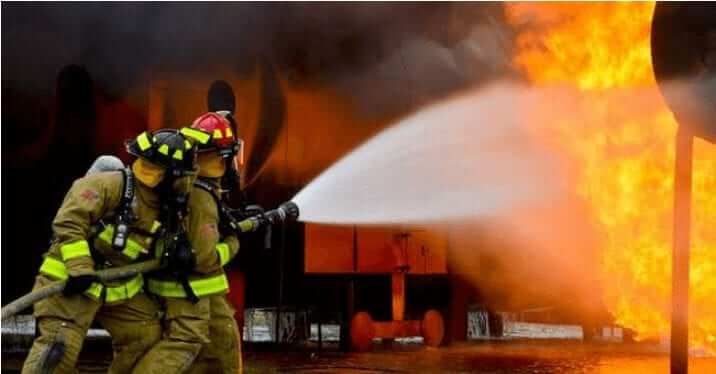
One of your worst nightmares as a business owner is to watch your building go up in flames -- literally. Unfortunately, this happens more often than you might think. Let's look at fire rated doors.
Research shows that between 2008 and 2017, more than 100,000 nonresidential fires ended up being reported every year and led to about 95 deaths, nearly $3 billion worth of property damage, and 1,200 injuries.
Commercial fires can easily happen if your building isn’t fireproof. This is why it is wise to install fire-rated doors versus non-fire-rated doors.
Here’s a rundown on doors and how they can help you to protect your business assets in the event of a fire.
Let’s get started!
Doors that are fire rated play a key role in helping to save lives as well as minimize property damage. They do this by compartmentalizing radiant heat, flames, and smoke. In addition they provide safe egress.
In a fire-rated door, multiple components work together as part of a single assembly. These components include the glazing, the hardware, the frame, and the door itself.
A testing agency that is nationally recognized typically tests these components as individual products, then classify them for fire door assembly use.
However, in other cases, an agency tests specific components together. In this situation, the components have to be utilized together to maintain their fire rating.
Unfortunately, with non-fire-rated doors, there is no testing-based proof that these doors’ components can preserve lives and protect property in the same way that fire-rated doors can.
Let’s dig deeper into the existing standards for fire-rated doors.
Many detailed requirements for fire-rated doors are present in the National Fire Protection Association 80, or NFPA 80, code.
You can also find smoke door requirements in the NFPA 105, which covers how a person should install a smoke door assembly.
Several standards and codes reference the NFPA 105 and 80. These other standards include the following:
The NFPA 101, a code on life safety
The International Fire Code
The International Building Code
Note that as a general rule of thumb, fire doors must feature positive latching and also be able to close on their own.
Although many standards and codes exist for fire protection, as mentioned above, none of these are actually laws. As a result, they aren't enforceable by themselves.
Still, the majority of governing agencies utilize these codes as their building requirements. As part of this process, these agencies give their inspectors the authority to enforce the standards.
The fire codes for commercial buildings at the county or city level cover a variety of dangers that may arise in connection with a fire. These include occupancy limits, which exist to ensure that individuals can easily access egress points and thus safely exit buildings that are on fire.
Fire codes may also be used to address the various situations in which commercial buildings are to be used. In addition, rules exist for how far apart adjacent spaces exist in a building to prevent smoke and fire from spreading within the building.
A door must undergo endurance testing. During this type of test, it ends up being exposed to heat as extreme as 1925 degrees Fahrenheit. This takes place for up to 180 minutes.
Let’s say the door is able to limit flames and stays in the door frame without through openings. In this case, it receives a rating of 180 minutes, 90 minutes, 60 minutes, 45 minutes, or 20 minutes based on its performance.
Note that some fire doors are referred to using letter designations. For instance, “A” stands for a total of three hours. Also, “B” stands for between 60 and 90 minutes.
Meanwhile, “C” stands for a total of 45 minutes. In addition, doors rated for 20 minutes do not feature letters.
Nonetheless, you’ll likely find that companies use the quantity of minutes more often than they do letters.
Fire doors can be held open with a holder/closer combination that features an integral smoke detector or is initiated by an alarm. Electromagnetic holders can also be used for holding open these doors.
As soon as smoke ends up being detected, the fire door closes. Then, it provides between 20 minutes and 180 minutes’ worth of fire protection.
When it comes to commercial doors and fire ratings, note that there are differences among various types of door materials.
For instance, steel doors are generally viewed as being the best-performing type of commercial door for fire protection. These metal doors are among the only ones capable of providing up to three hours of protection.
Wood fire-rated doors generally offer up to 90 minutes of protection. Top-quality doors offer superior strength for holding screws as well as split resistance.
We offer top-of-the-line commercial fire rated doors designed to suit a number of client situations.
For instance, we offer 90-minute fire-rated metal doors that come with glass windows for adding light to any room. We also offer wood doors that can be used for corridor and room partition openings in which doors that have been rated are required.
With our doors, you can easily provide extra safety to your building occupants. In addition, you can increase your chances of protecting your business assets.
Get in touch with us to learn more about all of our commercial fire-rated door options and choose the best ones for your unique needs today!
September 3, 2020
Wayne Foreman